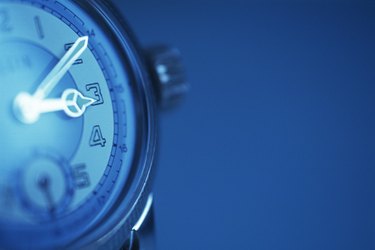
The face of a watch is a window to not only the intricate design and details of your favorite accessory, but also the timekeeping function it's meant for. A polished, scratch-free face is important to the appearance of your wrist adornment, but sometimes scratches are an inevitable occurrence, especially when you wear your watch daily.
Things You'll Need
Masking tape
Diamond pastes 3µ and .25µ
Polishing cloth
Toothpaste
Video of the Day
Determine the Watch Face Material
Step 1
Use this simple rule of thumb: Watch faces made from acrylic -- a type of plastic -- are found on many less expensive watches or those made prior to the 1980s. These watch faces are very easily scratched, so if you have multiple scratches, it's very likely your watch face is acrylic.
Video of the Day
Step 2
Consider the age of your watch. If you have a newer, more expensive watch, the face is most likely made from mineral glass or sapphire crystal. These new watch faces are much harder to scratch, and it's therefore much harder to remove a scratch.
Step 3
Contact your watch manufacturer to find out what the watch face is made of, if you are in doubt, but beware -- a manufacturer or repair shop will most likely tell you a new face is the only solution if the material is mineral or sapphire glass. This can cost upward of $250, but there is a trusty DIY alternative.
Remove Scratches From Sapphire or Mineral Glass Faces
Step 1
Cover the bezel of your watch (the rim around the glass face) with masking tape.
Step 2
Apply a small amount of 3µ diamond paste to the scratched area, and let it sit for one minute.
Step 3
Rub the paste firmly in a circular motion for several minutes or until you see the scratch disappear, using a polishing cloth.
Step 4
Apply a small dab of .25µ paste to the watch face, and work it in a circular motion with a clean section of your polishing cloth.
Step 5
Wipe away the excess paste with a clean section of your cloth and remove the masking tape when the scratch has completely disappeared and you are satisfied with the results. If the scratch is still visible, repeat Steps 2 to 4.
Remove Scratches From Acrylic Watch Faces
Step 1
Apply a dime-sized amount of regular non-gel household toothpaste directly to your watch face, in an area that is well lit enough to see all the scratches.
Step 2
Work the paste in a circular motion with a clean polishing cloth.
Step 3
Wipe the watch face clean with your cloth. If scratches are still visible, reapply the toothpaste, flatten it into the scratched area, and let it sit for five minutes.
Step 4
Work the toothpaste once again in a circular motion, applying slight pressure.
Step 5
Buff the watch face with a clean portion of your cloth, using the same circular motion, wiping all of the toothpaste clean.
Tip
You can buy diamond paste, also referred to as “diamond compound,” from a number of online sources, as well as jewelry or dental supply retailers. The abrasiveness of the paste is measured by microns, symbolized by the Greek lowercase mu (µ).
If using a polishing cloth doesn’t seem to work, try a more high-powered rotary tool with a felt tip attached.
If the scratch is extremely deep -- deeper than a hairline scratch -- crystal replacement by a professional may be the best option.
Warning
If you opt to use a rotary tool, always wear goggles and beware of possible heat generation by the friction.
Avoid getting diamond compound on your watch band or any other areas surrounding the face. For added security, remove the watch band and bezel entirely for protection.